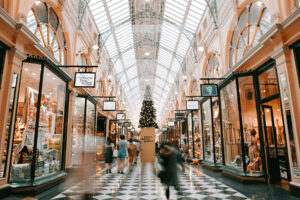From the pandemic years through to post Covid-recovery, coupled with increasing geopolitical events, it has been a prolonged and difficult environment for consumers. With high inflation occurring here, in the UK and around the world, the Bank of England and other international central banks have systematically had to raise interest rates. UK interest rates have gone from a historic low of 0.1% in March 2020 to a current rate of 5.25%, with the steepest raises occurring over the last 18 months. Both inflationary prices of goods and services and interest rate jumps have effectively put less and less disposable income into consumers’ pockets.
As a result, the retail industry will have to face a year during which we learn the true state of consumer consumption in a post-Covid world; one without economic biases such as low interest rates, surges of governmental cash support, disrupted supply chains and damaging inflation. Will the emerging ‘normal’ consumer economy continue to grow as it has for the last few years, plateau or stagnate? I believe growth will be hard fought, but it will be gradual provided that war or other geopolitical events do not divert the effort. Therefore, the retail industry will need to continue to adapt and innovate to engage consumers into making more informed and selective choices.
What I am confident about is that there will be an accelerating pace of change to adapt and innovate in the retail, e-commerce, and consumer parcelled goods industries. The pace is being driven by evolving consumer demands, technology advancements and adaptation, as well as the integration of in-store and online shopping into a cohesive omni-channel experience.
In the current retail environment, it is the customers’ expectation for personalisation, speed, and lower costs that is driving industry innovation. Retailers are embracing omni-channel strategies which enable them to better understand and serve consumers’ specific needs as they move through multiple digital and physical touchpoints. Data has become ever so important in this evolving retail landscape. As customers move through the channels, applications are leveraged and data is collected to personalise the customer’s experience, provide a consistent brand experience, optimise customer satisfaction, and facilitate data-driven merchandising outcomes. This year, retailers will be focusing more of their efforts on “social commerce,” which combines e-commerce with the power of social media. GenZ’s preference towards non-stop connectivity is driving their buying preferences to completing a transaction via fewer clicks on their digital devices. So, 2024 will be the year where we will see an increased uptake of browsing products, reading reviews, and making purchases on just one social media application.
The potential of Augmented Reality in customer experience
In direct contrast to this trend, I believe the majority of consumers still find the biggest drawback to shopping online is not being able to “touch, see and feel a product.” This impediment highlights the potential and competitive advantage that the deployment of Augmented Reality (AR) has to enhance the customer experience. We’ve already seen industries such as fashion, beauty and automotive, trial AR within their respective customer journeys. I imagine that we will see further advances in virtual “try-before-you-buy” features that will fulfil consumer’s needs, assist with longer-term, sustainable solutions, and reduce waste.
As digitally native shoppers become the norm of the marketplace, retailers are turning more and more to augmented reality to improve the relationships between consumers and brands. As an example and whilst not necessarily new, virtual tools allow unlimited try-on of cosmetics, at L’Oreal “Artist” tools allow shoppers to test out shades of lipstick, blush, foundation, eyeshadow, and more without having to leave the comfort of their chosen “shopping place.”
Sephora uses AR fitting rooms in store where a customers’ skin is scanned to match it with the right foundation or lipsticks allowing unlimited ‘try-on’ of cosmetics to make more informed choices. Similarly, SmartBuyGlasses assist with detailed, 3D frames that automatically fit the head of any customer. Gucci was one of the first luxury brands to allow shoppers to try on a pair of sneakers using AR. Nike took it one step further by using AR technology to let customers customise their shoe design with different colours and patterns before they buy them. Shoppers at Apple use AR Quick Look for new iPhone or iMac models, so one can see what the device will look like in the home or office space or in their hand. AR will potentially allow consumers to look at any items in 3D, learn their characteristics, and then buy with a couple of clicks.
Shoppers still crave physical experience
Whilst there is a great focus on AR and tech influences on the sector, brick-and-mortar and High Streets are not dying. The only retail that is dying is ‘boring retail’. In my opinion, shoppers still crave a physical experience, yet an overwhelming majority acknowledge they can’t recall the last time a brand truly excited them. Retailers in 2024 must work towards stepping up their game in creating highly interactive, engaging and entertaining experiences to inject “joy and excitement” into their brick-and-mortar and digital marketing experiences.
The year ahead will also require retailers to focus on sustainability, however, the areas of retailers’ efforts will shift. There will be an increased urgency in embedding sustainability practices across its supply chain and operations and adopting of ESG practices as a part of its core business initiatives to respond to new CSRD regulation. Equally, attention on how to incorporate sustainability into the actual lifecycle of their product will be a key opportunity. As Millennials and Gen Z mature into ‘intelligent consumers’ – those having a considered view of consumerism with respect for the planet – they will be attracted to sustainable buying options. Their buying choices will be increasingly affected by the growing costs of first-hand goods as a result of global economic pressures so having a wider selection of sustainable options will be a competitive advantage. Artificial Intelligence (AI) will continue to be a highly talked about tool as retailers learn to harness its applications across sustainability proposals. According to Deloitte, “AI can assist in the design of circular products, improve traceability, and make forecasting functions more accurate, helping to reduce wastage from excess inventory. AI can be used to cut out waste right from the design stage of the product lifecycle and is estimated to unlock a potential value of USD 90 billion every year in the consumer electronics category, and USD 127 billion in the food category.”
So, will 2024 bring more fully integrated retail models incorporating augmented reality (AR), combined with experiential retail models? With a new generation of intelligent consumers becoming more demanding regarding experience, value and sustainability within an economic environment which will require more prioritised spending, the future of retail will continue to evolve.

Gregory Fonseca
Gregory Fonseca is the Director of Architecture at BDP and a Member of the ACROSS Advisory Board.
Read more about expert opinions in our Online Special: “Industry Outlook 2024”






